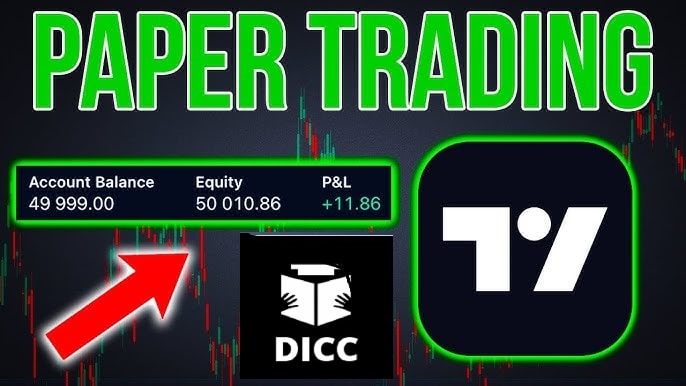The stock market is notorious for its volatility, and making consistent profits can be challenging without proper knowledge and strategy. But what if you could learn to trade accurately without risking your hard-earned money? That’s where paper trading comes in. This guide will explain everything you need to know about paper trading in a straightforward and easy-to-understand way.
| Section | Details |
|---|---|
| What Is Paper Trading? | Simulation of real trading using virtual money to practice and test strategies without financial risk. |
| Why It’s Important | – Risk-Free Learning: Learn market dynamics without losing money.- Strategy Testing: Test new ideas safely. |
| How to Start | – Choose Platform: Options include TradingView, Zerodha.- Set Up Account: Create username, provide info. |
| Improving Skills | – Familiarize Interface: Learn trading dashboard, portfolio summary.- Develop Strategy: Focus on stocks, options, set goals.- Placing Trades: Trade with virtual money, adjust approach.<br>- Analyze Performance: Review successful and unsuccessful trades. |
| Benefits | – No financial risk- Test strategies- Understand market dynamics |
| Limitations | – Emotional detachment- Market discrepancies (e.g., liquidity issues, execution delays) |
| Conclusion | Paper trading is a risk-free way to learn and test strategies, beneficial for both beginners and experienced traders. |
Table of Contents
Understanding the Basics of Paper Trading
Paper trading is a simulation of actual trading where you can practice buying and selling stocks, options, or other financial instruments without using real money. Think of it as a trading video game that mimics the real market. It’s an invaluable tool for both new and experienced investors to test strategies and learn the ropes without any financial risk.
Why Paper Trading is Important
Risk-Free Learning
One of the primary benefits of paper trading is that it allows you to learn how to trade without any financial risk. You get to understand market dynamics, how different trading strategies work, and how to react to market changes without losing a single penny.
Testing Strategies
Even seasoned traders use paper trading to test new strategies. Before putting real money on the line, you can see if your new idea works in a simulated environment. If it doesn’t, you can tweak your approach and test again without any financial loss.
How to Get Started with Paper Trading
Choosing a Platform
To begin paper trading, you’ll need a platform that offers this service. Many brokerage firms and financial websites provide free paper trading accounts. Some popular options include TradingView, Zerodha, and others.
Setting Up Your Account
Once you’ve chosen a platform, opening a paper trading account is usually straightforward. You’ll create a username, provide some basic information, and you’re ready to start trading with virtual money.
How to Improve Your Paper Trading Skills
Familiarize Yourself with the Platform
Spend some time getting familiar with the platform’s interface. Learn to find critical functions like the trading dashboard, portfolio summary, and market information. Understanding the interface is crucial for smooth paper trading.
Develop a Strategy
Developing your trading strategy is essential before you start making trades. Decide whether you will focus on stocks, options, or technical indicators. Set your goals and determine your risk tolerance. A clear strategy will guide your decisions and help you stay disciplined.
Placing Trades
Now comes the fun part—placing trades! Using your virtual money, start trading according to your strategy. Pay attention to how the market responds to your trades and adjust your approach accordingly.
Analyzing Your Performance
After you’ve been paper trading for a while, review your performance. Look at which trades were successful and which were not. This analysis will help you understand your strengths and weaknesses and refine your strategy.
Benefits and Limitations of Paper Trading
Benefits
- No Financial Risk: You can learn and test without risking real money.
- Strategy Testing: Perfect for testing new trading ideas.
- Market Familiarity: Helps you get comfortable with market dynamics and trading tools.
Limitations
- Emotional Detachment: Since no real money is involved, you might not experience the emotional highs and lows of actual trading.
- Market Discrepancies: Simulated trading might not perfectly mimic real market conditions, like liquidity issues or execution delays.
Conclusion
Paper trading is a fantastic way to enter the world of trading without any risk. It allows you to learn, practice, and test strategies in a safe environment. Whether you are a beginner or an experienced trader, paper trading can provide valuable insights and help you become a successful trader. Remember, the key to getting the most out of paper trading is to treat it seriously, just as you would with real money.
FAQs
Yes, most platforms offer paper trading for free. It’s a great way to practice without any financial commitment.
No, you cannot lose real money while paper trading. It’s a simulation, so any losses or gains are virtual.
It’s recommended to paper trade for at least three to six months. This period gives you enough time to learn, test strategies, and build confidence.
Many platforms offer paper trading, including TradingView, Zerodha, and several others. Choose one that suits your needs and preferences.
Focus on developing and testing your trading strategy, understanding market dynamics, and getting comfortable with the trading platform. This preparation will help you when you start trading with real money.
